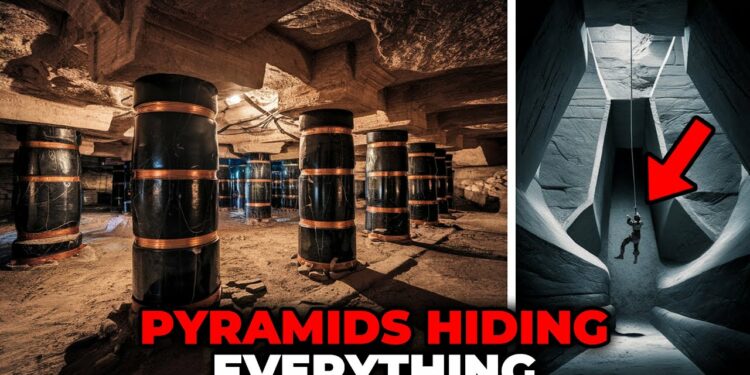Beneath the Pyramid of Khafre at Giza, a potential archaeological bombshell has emerged, challenging everything we thought we knew about this ancient site. Advanced radar scans, conducted by Professor Curado Malanga from the University of Pisa and radar expert Dr. Filippo Biandi from the University of Strathclyde, have revealed what appears to be a vast subterranean complex. Using synthetic aperture radar (SAR), satellite-based imaging, and seismic echo mapping, their team uncovered evidence of spiral shafts plunging over 600 meters deep, colossal 80-meter cubic chambers, and structures the size of city blocks—all buried beneath the pyramid. These findings, presented in a dramatic reveal in Italy, suggest an engineered underground city, far more complex than the simple burial chamber traditionally associated with Khafre’s pyramid.
The Great Pyramid of Khufu has long overshadowed Khafre’s, with its intricate chambers and mysterious voids. Khafre’s pyramid, by contrast, was considered straightforward: a single granite sarcophagus in a bedrock chamber, devoid of treasures or hieroglyphs. But these new scans challenge that view, hinting that the pyramid may sit atop a forgotten underworld, possibly more than a tomb—a monument or even a functional structure. The images show symmetrical, man-made formations, evoking myths of the “Hall of Amenti,” ancient chambers said to hold esoteric knowledge. While some see echoes of these legends, others, like Egypt’s prominent Egyptologist Dr. Zahi Hawass, dismiss the claims as baseless, citing a lack of peer-reviewed evidence and official authorization.
The technology behind this discovery is groundbreaking. Unlike traditional archaeology, which relies on physical excavation, Malanga and Biandi used SAR to send radar pulses from satellites, capturing echoes to create high-resolution 3D images. Combined with Doppler tomography and microseismic activity—natural Earth tremors acting like sonar—their method illuminated hidden structures with unprecedented clarity. The scans revealed eight spiraling shafts, massive cubic chambers, and possible corridors, suggesting a deliberate, sophisticated design. Critics, however, argue that radar alone cannot confirm such claims. Traditional ground-penetrating radar struggles to penetrate dense limestone beyond a few meters, and without excavation, the findings remain speculative.
The discovery has reignited debates about the purpose of the pyramids. Could they be more than tombs? Some propose they were functional, perhaps harnessing Earth’s natural frequencies as Nikola Tesla and engineer Christopher Dunn once speculated, with the underground complex serving as an ancient power system or ritualistic temple tied to the Egyptian concept of the Duat, the underworld. The scale and symmetry of the structures also raise questions about their builders. Were they constructed by the Old Kingdom Egyptians, or do they predate them, hinting at a lost civilization? Researcher Armando Mei suggests an origin as early as 36,400 BCE, linking the architecture to the mythic reign of Thoth, though mainstream historians reject this as fantasy. Sites like Göbekli Tepe, dated to 12,000 years ago, lend some credence to the idea that ancient peoples were capable of advanced construction.
Skeptics, including Dr. Arlland Connors, caution that subsurface voids are plausible, but entire cities buried kilometers deep stretch credibility. Without drilling or cameras to verify the scans, the debate remains stalled by Egypt’s strict regulations, controlled by the Supreme Council of Antiquities. Hawass insists no such radar studies were permitted, and official approval for excavation is unlikely. Yet, the images—perfect geometric shapes and spiraling corridors—are hard to dismiss, fueling speculation about a hidden chapter of history.
This discovery has shifted the conversation, blending science, myth, and technology. The idea of an underground network beneath Giza suggests the visible pyramids may be just the surface of a deeper, older legacy. Whether a functional machine, a temple, or an archive of a forgotten civilization, the findings challenge assumptions about ancient capabilities. The Giza Plateau, long a symbol of human ingenuity, now pulses with new possibility. Until excavation is permitted, the truth remains buried, leaving us with tantalizing images and questions that echo across millennia. The sands of Egypt continue to whisper, and the story of Khafre’s pyramid is far from over.























